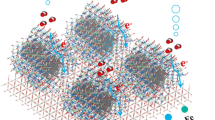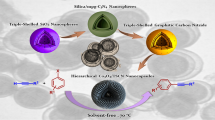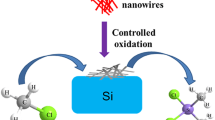Abstract
Up to now, although tremendous effort has been made in exploring Pd-based catalysts for the Suzuki–Miyaura coupling reactions, there is still much room to enhance its catalytic performance by synthesis catalyst with define-designed and tailored structure. Herein, a new kind of Pd-based structured catalyst with hierarchical hollow structure (Pd/Co(OH)2/Cu(OH)2/copper foam) has been successfully synthesized by three facile steps. As framework, the hierarchical hollow nanoarray structure of Co(OH)2/Cu(OH)2/copper foam is fabricated by immersion and electrolytic deposition methods. Uniformly dispersed Pd nanoparticles with a narrow size distribution (1.5 ± 0.2 nm) are anchored on the surface of the hierarchical nanotube array through an in situ spontaneous redox reaction between Co(OH)2 and PdCl42− without any surfactant at room temperature. Compared with other synthesis approaches, it just takes less than 1 h for the whole fabrication process in our strategy, exhibiting very high efficiency. In order to evaluate the catalytic performance of the as-prepared structured catalyst, 16 kinds of reagents were chosen as substrates for Suzuki–Miyaura coupling reaction, exhibiting excellent activity and reusability under mild conditions. We hope this simple and efficient method will open a new strategy to design and prepare structured catalysts.




Similar content being viewed by others
References
Corbet JP, Mignani G (2006) Selected patented cross-coupling reaction technologies. Chem Rev 106(7):2651–2710
Johansson Seechurn CC, Kitching MO, Colacot TJ, Snieckus V (2012) Palladium-catalyzed cross-coupling: a historical contextual perspective to the 2010 nobel prize. Angew Chem Int Ed 51(21):5062–5085
Balanta A, Godard C, Claver C (2011) Pd nanoparticles for C–C coupling reactions. Chem Soc Rev 40(10):4973–4985
Ye R, Zhukhovitskiy AV, Deraedt CV, Toste FD, Somorjai GA (2017) Supported dendrimer-encapsulated metal clusters: toward heterogenizing homogeneous catalysts. Acc Chem Res 50(8):1894–1901
Yin LX, Liebscher J (2007) Carbon-carbon coupling reactions catalyzed by heterogeneous palladium catalysts. Chem Rev 107(1):133–173
Molnar A (2011) Efficient, selective, and recyclable palladium catalysts in carbon–carbon coupling reactions. Chem Rev 111(3):2251–2320
Kong LR, Lu XF, Jin E, Jiang S, Wang C, Zhang WJ (2009) Templated synthesis of polyaniline nanotubes with Pd nanoparticles attached onto their inner walls and its catalytic activity on the reduction of p-nitroanilinum. Compos Sci Technol 69(5):561–566
Collins G, Schmidt M, O’Dwyer C, McGlacken G, Holmes JD (2014) Enhanced catalytic activity of high-index faceted palladium nanoparticles in Suzuki–Miyaura coupling due to efficient leaching mechanism. ACS Catal 4(9):3105–3111
Kim SW, Kim M, Lee WY, Hyeon T (2002) Fabrication of hollow palladium spheres and their successful application to the recyclable heterogeneous catalyst for Suzuki coupling reactions. J Am Chem Soc 124(26):7642–7643
Li R, Zhang P, Huang YM, Zhang P, Zhong H, Chen QW (2012) Pd–Fe3O4@C hybrid nanoparticles: preparation, characterization, and their high catalytic activity toward Suzuki coupling reactions. J Mater Chem 22(42):22750–22755
Dadras A, Naimi-Jamal MR, Moghaddam FM, Ayati SE (2018) Suzuki–Miyaura coupling reaction in water in the presence of robust palladium immobilized on modified magnetic Fe3O4 nanoparticles as a recoverable catalyst. Appl Organometal Chem 32(2):e3993. https://doi.org/10.1002/aoc.3993
Moussa S, Siamaki AR, Gupton BF, El-Shall MS (2011) Pd-partially reduced graphene oxide catalysts (Pd/PRGO): laser synthesis of Pd nanoparticles supported on PRGO nanosheets for carbon–carbon cross coupling reactions. ACS Catal 2(1):145–154
Ohtaka A, Teratani T, Fujii R, Ikeshita K, Shimomura O, Nomura R (2009) Facile preparation of linear polystyrene-stabilized Pd nanoparticles in water. Chem Commun 46:7188–7190
Hariprasad E, Radhakrishnan TP (2012) Palladium nanoparticle-embedded polymer thin film “dip catalyst” for Suzuki–Miyaura reaction. ACS Catal 2(6):1179–1186
Corma A, Garcia H, Leyva A (2002) Bifunctional palladium-basic zeolites as catalyst for Suzuki reaction. Appl Catal A 236(1):179–185
Gniewek A, Ziolkowski JJ, Trzeciak AM, Zawadzki M, Grabowska H, Wrzyszcz J (2008) Palladium nanoparticles supported on alumina-based oxides as heterogeneous catalysts of the Suzuki-Miyaura reaction. J Catal 254(1):121–130
Panahi L, Naimi-Jamal MR, Mokhtari J (2018) Ultrasound-assisted suzuki-miyaura reaction catalyzed by Pd@Cu2(NH2-BDC)2(DABCO). J Organomet Chem 868:36–46
Tahmasebi S, Mokhtari J, Naimi-Jamal MR, Khosravi A, Panahi L (2017) One-step synthesis of Pd-NPs@Cu2(BDC)2(DABCO) as efficient heterogeneous catalyst for the Suzuki–Miyaura cross-coupling reaction. J Organomet Chem 853:35–41
Yılmaz NB, Baran T, Menteş A (2018) Production of novel palladium nanocatalyst stabilized with sustainable chitosan/cellulose composite and its catalytic performance in Suzuki–Miyaura coupling reactions. Carbohydr Polym 181:596–604
Baran T, Inanan T, Menteş A (2016) Synthesis, characterization, and catalytic activity in Suzuki coupling and catalase-like reactions of new Chitosan supported Pd catalyst. Carbohydr Polym 145:20–29
Baran T, Sargin I, Kaya M, Menteş A (2016) Green heterogeneous Pd(II) catalyst produced from chitosan-cellulose micro beads for green synthesis of biaryls. Carbohydr Polym 152:181–188
Baran T, Baran NY, Menteş A (2018) Sustainable chitosan/starch composite material for stabilization of palladium nanoparticles: synthesis, characterization and investigation of catalytic behaviour of Pd@chitosan/starch nanocomposite in Suzuki–Miyaura reaction. Appl Organometal Chem 32(2):e4075. https://doi.org/10.1002/aoc.4075
Baran T, Baran NY, Menteş A (2017) A new air and moisture stable robust bio-polymer based palladium catalyst for highly efficient synthesis of biaryl compounds. Appl Organomet Chem 32(2):e4076. https://doi.org/10.1002/aoc.4076
Baran T (2017) Practical, economical, and eco-friendly starch-supported palladium catalyst for Suzuki coupling reactions. J Colloid Interface Sci 496:446–455
Baran NY, Baran T, Menteş A (2016) Fabrication and application of cellulose Schiff base supported Pd(II) for fast and simple synthesis of biaryls via Suzuki coupling reaction. Appl Catal A 531:36–44
Baran T, Baran NY, Menteş A (2018) Preparation, structural characterization, and catalytic performance of Pd(II) and Pt(II) complexes derived from cellulose schiff base. J Mol Struct 1160:154–160
Baran T (2018) Ultrasound-accelerated synthesis of biphenyl compounds using novel Pd(0) nanoparticles immobilized on bio-composite. Ultrason Sonochem 45:231–237
Baran T (2018) Pd(0) nanocatalyst stabilized on a novel agar/pectin composite and its catalytic activity in the synthesis of biphenyl compounds by suzuki-miyaura cross coupling reaction and reduction of o-nitroaniline. Carbohydr Polym 195:45–52
Baran T, Baran NY, Menteş A (2018) An easily recoverable and highly reproducible agar-supported palladium catalyst for Suzuki–Miyaura coupling reactions and reduction of o -nitroaniline. Int J Biol Macromol 115:249–256
Duan LL, Fu R, Xiao ZG, Zhao QF, Wang JQ, Chen SJ, Wan Y (2015) Activation of aryl chlorides in water under phase-transfer agent-free and ligand-free Suzuki coupling by heterogeneous palladium supported on hybrid mesoporous carbon. ACS Catal 5(2):575–586
Liu HY, Zhang LY, Wang N, Su DS (2014) Palladium nanoparticles embedded in the inner surfaces of carbon nanotubes: synthesis, catalytic activity, and sinter resistance. Angew Chem Int Ed 53(46):12634–12638
Yamada YM, Yuyama Y, Sato T, Fujikawa S, Uozumi Y (2014) A palladium-nanoparticle and silicon-nanowire-array hybrid: a platform for catalytic heterogeneous reactions. Angew Chem Int Ed 53(1):127–131
Feng JX, Xu H, Dong YT, Ye SH, Tong YX, Li GR (2016) FeOOH/Co/FeOOH hybrid nanotube arrays as high-performance electrocatalysts for the oxygen evolution reaction. Angew Chem Int Ed 128:3758–3762
Xie LS, Tang C, Wang KY, Du G, Asiri AM, Sun XP (2017) Cu(OH)2@CoCO3(OH)2·nH2O Core-Shell heterostructure nanowire array: an efficient 3D anodic catalyst for oxygen evolution and methanol electrooxidation. Small 13(7):1602755. https://doi.org/10.1002/smll.201602755
Cao XH, Yin ZY, Zhang H (2014) Three-dimensional graphene materials: preparation, structures and application in supercapacitors. Energy Environ Sci 7(6):1850–1865
Yu Z, Tetard L, Zhai L, Thomas J (2015) Supercapacitor electrode materials: nanostructures from 0 to 3 dimensions. Energy Environ Sci 8(3):702–730
Wang JX, Zhang QB, Li XH, Zhang B, Mai LQ, Zhang KL (2015) Smart construction of three-dimensional hierarchical tubular transition metal oxide core/shell heterostructures with high-capacity and long-cycle-life lithium storage. Nano Energy 12:437–446
Xu YK, Xuan HC, Gao JH, Liang T, Han XK, Yang J, Zhang YQ, Li H, Han PD, Du YW (2018) Hierarchical three-dimensional NiMoO4-anchored rGO/Ni foam as advanced electrode material with improved supercapacitor performance. J Mater Sci 53(11):8483–8498. https://doi.org/10.1007/s10853-018-2171-1
Zhang DB, Shao Y, Kong XG, Jiang MH, Lei DQ, Lei XD (2016) Facile fabrication of large-area hybrid Ni-Co hydroxide/Cu(OH)2/copper foam composites. Electrochim Acta 218:294–302
Yu L, Zhou HQ, Sun JY, Qin F, Yu F, Bao JM, Yu Y, Chen S, Ren ZF (2017) Cu nanowires shelled with NiFe layered double hydroxide nanosheets as bifunctional electrocatalysts for overall water splitting. Energy Environ Sci 10(8):1820–1827
Sun JQ, Li YP, Liu XJ, Yang Q, Liu JF, Sun XM, Evans DG, Duan X (2012) Hierarchical cobalt iron oxide nanoarrays as structured catalysts. Chem Commun 48(28):3379–3381
Hu QY, Liu XW, Tang LT, Min DW, Shi TC, Zhang W (2017) Pd–ZnO nanowire arrays as recyclable catalysts for 4-nitrophenol reduction and Suzuki coupling reactions. RSC Adv 7(13):7964–7972
Fu QR, Meng Y, Fang ZL, Hu QQ, Xu L, Gao WH, Huang XC, Xue Q, Sun YP, Lu FS (2017) Boron nitride nanosheet-anchored Pd-Fe core-shell nanoparticles as highly efficient catalysts for Suzuki–Miyaura coupling reactions. ACS Appl Mater Interfaces 9(3):2469–2476
Zhao JW, Shao MF, Yan DP, Zhang ST, Lu ZZ, Li ZX, Cao XZ, Wang BY, Wei M, Evans DG (2013) A hierarchical heterostructure based on Pd nanoparticles/layered double hydroxide nanowalls for enhanced ethanol electrooxidation. J Mater Chem A 1(19):5840–5846
Hou CC, Wang CJ, Chen QQ, Lv XJ, Fu WF, Chen Y (2016) Rapid synthesis of ultralong Fe(OH)3: Cu(OH)2 core-shell nanowires self-supported on copper foam as a highly efficient 3D electrode for water oxidation. Chem Commun 52:14470–14473
Feng JX, Ding LX, Ye SH, He XJ, Xu H, Tong YX, Li GR (2015) Co(OH)2 @PANI hybrid nanosheets with 3D networks as high-performance electrocatalysts for hydrogen evolution reaction. Adv Mater 27(44):7051–7057
Ma RZ, Liang JB, Takada K, Sasaki T (2011) Topochemical synthesis of Co-Fe layered double hydroxides at varied Fe/Co ratios: unique intercalation of triiodide and its profound effect. J Am Chem Soc 133(3):613–620
Shi WW, Chen XQ, Xu SY, Cui JB, Wang LY (2016) Highly efficient PdCu3 nanocatalysts for Suzuki–Miyaura reaction. Nano Res 9(10):2912–2920
Nie RF, Shi JJ, Du WC, Hou ZY (2014) Ni2O3-around-Pd hybrid on graphene oxide: an efficient catalyst for ligand-free Suzuki–Miyaura coupling reaction. Appl Catal A 473(5):1–6
Xia JW, Fu YS, He GY, Sun XQ, Wang X (2017) Core-shell-like Ni-Pd nanoparticles supported on carbon black as a magnetically separable catalyst for green Suzuki–Miyaura coupling reactions. Appl Catal B 200:39–46
Amali AJ, Rana RK (2009) Stabilisation of Pd (0) on surface functionalised Fe3O4 nanoparticles: magnetically recoverable and stable recyclable catalyst for hydrogenation and Suzuki–Miyaura reactions. Green Chem 11:1781–1786
Yu DD, Bai J, Wang JZ, Liang HO, Li CP (2016) Assembling formation of highly dispersed Pd nanoparticles supported 1D carbon fiber electrospun with excellent catalytic active and recyclable performance for Suzuki reaction. Appl Surf Sci 399:185–191
Ni XJ, Wu ZF, Gu XD, Wang DW, Yang C, Sun PD, Li YX (2017) In situ growth of clean Pd nanoparticles on polystyrene microspheres assisted by functional reduced graphene oxide and their excellent catalytic properties. Langmuir 33(33):8157–8164
Hong MC, Choi MC, Chang YW, Lee Y, Kim J, Rhee H (2012) Palladium nanoparticles on thermoresponsive hydrogels and their application as recyclable Suzuki–Miyaura coupling reaction catalysts in water. Adv Synth Catal 354:1257–1263
Labulo AH, Martincigh BS, Omondi B, Nyamori VO (2017) Advances in carbon nanotubes as efficacious supports for palladium-catalysed carbon–carbon cross-coupling reactions. J Mater Sci 52(16):9225–9248. https://doi.org/10.1007/s10853-017-1128-0
Baran T, Açıksöz E, Menteş A (2015) Carboxymethyl chitosan schiff base supported heterogeneous palladium(II) catalysts for suzuki cross-coupling reaction. J Mol Catal A-Chem 407:47–52
Wang Y, Dou L, Zhang H (2017) Nanosheet array-like palladium-catalysts pdx/rgo@coal-ldh via lattice atomic-confined in situ reduction for highly efficient heck coupling reaction. ACS Appl Mater Interfaces 9(44):38784–38795
Choudary BM, Madhi S, Chowdari NS, Kantam ML, Sreedhar B (2002) Layered double hydroxide supported nanopalladium catalyst for Heck-, Suzuki-, Sonogashira-, and Stille-type coupling reactions of chloroarenes. J Am Chem Soc 124(47):14127–14136
Acknowledgements
This work was supported by the 973 Program (No. 2014CB932104), the National Natural Science Foundation of China (Nos: 2177060378, U1707603 and 21521005) and the Program for Changjiang Scholars, Innovative Research Teams in Universities (No. IRT1205).
Author information
Authors and Affiliations
Corresponding authors
Electronic supplementary material
Below is the link to the electronic supplementary material.
Rights and permissions
About this article
Cite this article
Li, J., Kong, X., Jiang, M. et al. Uniformly dispersed Pd nanoparticles anchored Co(OH)2/Cu(OH)2 hierarchical nanotube array as high active structured catalyst for Suzuki–Miyaura coupling reactions. J Mater Sci 53, 16263–16275 (2018). https://doi.org/10.1007/s10853-018-2781-7
Received:
Accepted:
Published:
Issue Date:
DOI: https://doi.org/10.1007/s10853-018-2781-7




